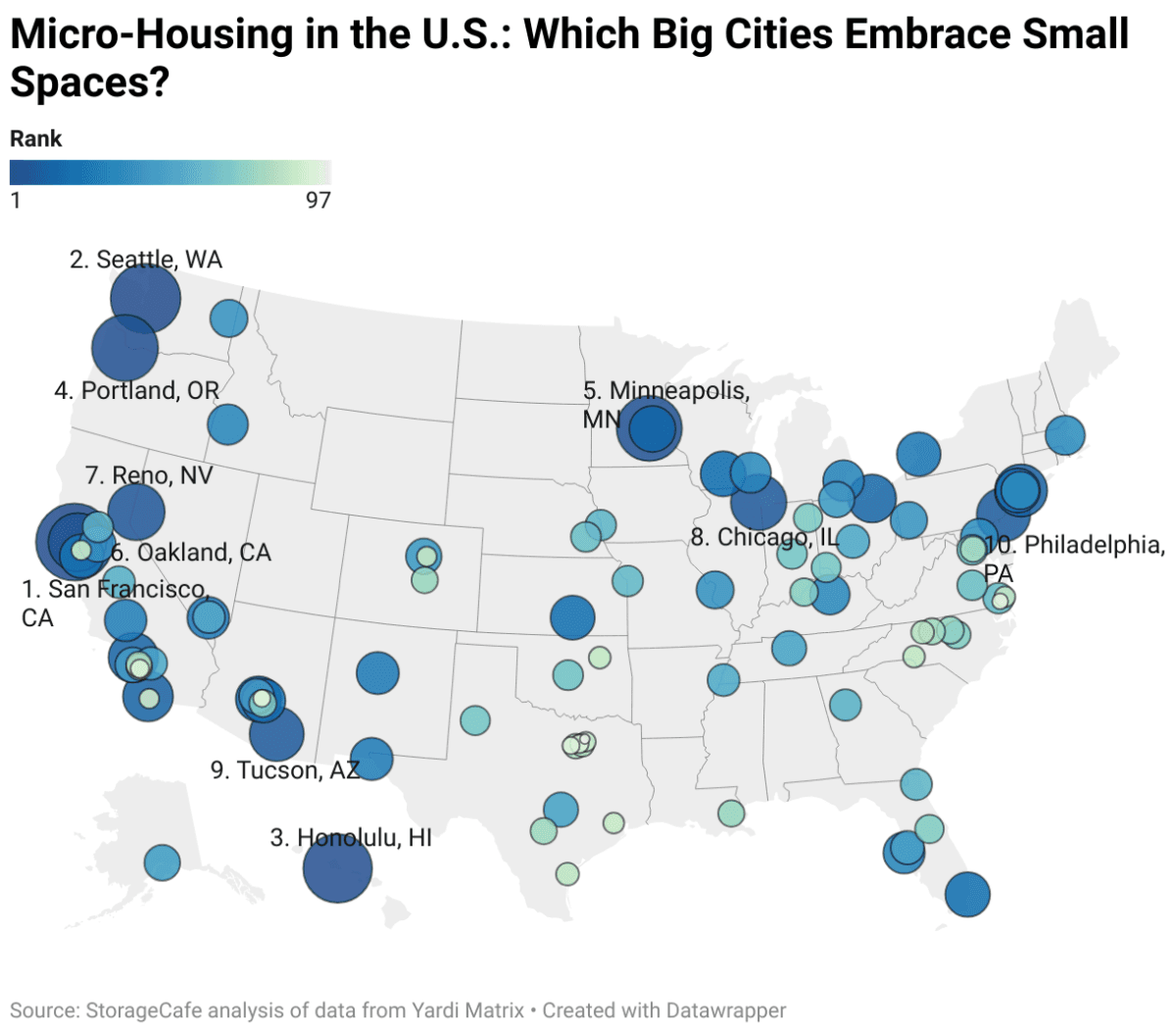The 18th-century children’s nursery rhyme—“There Was an Old Woman Who Lived in a Shoe”—may not be far from today’s reality as micro-housing —aka “the shoebox apartment”—is experiencing double-digit percentage increases across America, and in particular, in the West.
Doug Ressler, an analyst at StorageCafe, told The Epoch Times that mounting home and rental costs—especially in America’s priciest cities—are driving the creation of these alternate living spaces.
“These units rent for about half the price of traditional apartments and are attracting a lot of younger people,” he said.
“Many developments are located near college campuses and are being marketed not only to students, but to young professionals starting out and seeking to save money to eventually buy a home.”
Ressler noted that while finances may be a major reason for some renters to choose micro-housing, other factors include the fact that these mini-apartments are usually within walking distance of stores, restaurants, entertainment, parks, and other amenities.
“These projects are a mixture of new construction or adaptive reuse, such as a conversion of an office building or former school,” Ressler said. He added that this type of housing is also attractive to seniors or others living on fixed incomes, offering lower rents and low-maintenance lifestyles with convenient access to amenities and services.
One new project of note is the CITYSPACE Studio, a 39-unit micro-housing development now near completion in Berkeley, California. The housing is being constructed on a 5,000-square-foot lot, which had originally been zoned for a single-family home. Each of the units is just 160 square feet.
The building features furnished studios, stainless steel appliances, a community kitchen, laundry and social space, a private courtyard and community space, LED lighting, on-site management, and 24-hour security.
Developed by Panoramic Interests, this latest project has yet to publicize its rents. However, a similar development in Berkeley offering 330-square-foot studio apartments is renting for $2,095 a month.
“Neighborhoods near universities and hospitals also tend to command higher property values and rental rates due to this consistent influx of residents,” Ressler said. “For developers, this translates into a lower-risk investment with strong long-term appeal.”

Regionally, the West leads the nation in the share of micro-housing, followed by the Midwest and the Northeast.
Seattle has also emerged as a national leader in micro-housing, with these units comprising about 12 percent of the city’s total housing inventory. In addition, some 66 percent of rental units currently under construction fall into the micro-housing category.
“Because land is at a premium along coastal cities, you’re more likely to find this type of housing there,” Ressler said. “I think you may start to see more demand for micro-housing, especially in these areas.”
Minneapolis, Minnesota, leads the Midwest in micro-housing, with undersized units now accounting for 10.4 percent of the city’s total rental inventory—the highest share in the region. Chicago, Illinois, is also coming on board, where micro-units there are renting at nearly half the cost of conventional apartments.
In the Northeast, Newark, New Jersey, stands out for having one of the largest rent gaps between micro-units and conventional apartments. Renters there can expect to pay about 50 percent less for a micro-unit.
Top States for Tiny Homes
HomeGnome also recently ranked the top states for tiny homes, which are typically free-standing structures measuring less than 400 square feet. Texas topped the list, followed by Colorado, Tennessee, Oregon, and Georgia. California also ranked within the top 10. Texas, Colorado, and Virginia currently offer 14 or more tiny home communities, while Iowa, Texas, and Kentucky are noted as the hot spots for living “tiny” off the grid. Georgia hosts 4 tiny house festivals a year—more than any other state.“We are in a housing crisis, so any type of incremental housing can help fill the need. Many cities across the country are legalizing Accessory Dwelling Units (ADUs) to help with affordable workforce housing,” Krista Evans, director of Planning and Geography for Missouri State University, said in the HomeGnome report.
Housing in a Box
Enter BOXABL, a Las Vegas–based firm dedicated to solving the global housing crisis by offering brand-new homes that literally fold together and come fully equipped with appliances. Its most popular model, “The Casita,” is a 361-square-foot modular home with a living area, kitchen, bathroom, and bedroom. It also includes utility hookups for water, electricity, sewage, and internet. The studio casita currently sells for just $60,000.
Since it secured an initial prototype order from SpaceX and a subsequent order of 156 casita homes from the Department of Defense, BOXABL is continuing to streamline its manufacturing and ordering process to deliver its casitas more efficiently.
The company is planning to expand operations in Las Vegas and upgrade its inventory to offer prefabricated one- and two-bedroom casitas, as well as townhomes, single-family homes, and even apartment buildings.
Alexis Bulloch, BOXABL client relations manager, told The Epoch Times that since they began producing these units in 2021, they’ve received more than 190,000 inquiries.
“We’ve gotten requests for information from individuals seeking affordable housing, municipalities, and developers who want to plan casita communities,” she said. “Our goal is to solve the housing crisis not only here in America, but eventually on an international scale.”
According to Zillow, the United States is now short by about 4.5 million homes.
“These casitas unfold in about an hour, and it takes close to 24 hours for full installation, including the bathroom and kitchen appliances,” Bulloch said.
The homes are constructed with steel, concrete, and expanded polystyrene foam, and offer durable and structurally sound units. While they require minimal foundation work, potential owners must secure proper zoning allowances, as well as arrange for electricity and plumbing.
To date, 600 homes have been built and are available in 15 states. BOXABL also offers the “Baby Box,” a 120-square-foot RV unit selling for $19,999. It includes a kitchen, bathroom, dining area, pullout bed, a mini-split for heating and cooling, as well as storage space.
The company is also partnering with Bethel AME Church of Fontana to deliver affordable senior housing with 27 casitas. This project is among the first in California under the state’s Affordable Housing on Faith Lands Act.
In addition, the company has secured a contract with HORIZONS, a national hospitality group, to deliver 60 casitas to their new resort locations in South Carolina and California.







